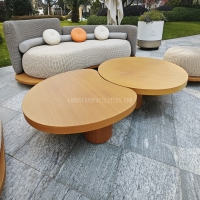Welcome to the website for landscape facilities products and knowledge.
How do you design a landscape bar counter to minimize the risk of spills or accidents?
Designing a landscape bar counter that minimizes spills and accidents requires a thoughtful blend of material science, ergonomics, and smart engineering. The goal is to create a space that is not only beautiful and inviting but also inherently safe and functional for both staff and guests. Here’s a comprehensive guide to achieving that.
First, the choice of materials is paramount. Opt for durable, slip-resistant surfaces for the countertop itself, even when wet. Textured granite, quartz composites, or finished concrete are excellent choices, providing grip for glasses. For the flooring surrounding the bar, avoid smooth tiles or polished stone. Instead, use brushed stone, textured pavers, or composite decking to ensure stable footing in all weather conditions.
The design of the countertop's surface is a critical factor. Incorporating a slight, almost imperceptible slope—for instance, a 1-2% grade—guides condensation and minor spills away from guests and toward a strategic drainage point. This subtle incline prevents liquid from pooling at the edge where elbows rest. Integrating a discrete drainage channel or groove along the back of the counter, leading to a hidden drain, efficiently captures runoff without compromising the bar's aesthetic.
Bar edge design also plays a crucial role. A raised lip or a bullnose edge can act as a subtle barrier, preventing items from easily sliding off. However, this lip must be designed carefully to be comfortable for guests leaning on the counter and easy for staff to wipe clean.
Adequate and strategic lighting is non-negotiable for safety. Ensure the entire bar surface and the immediate surrounding area are well-lit to eliminate shadows and tripping hazards. Low-voltage LED strip lighting under the bar counter's lip can illuminate the footing area, while overhead task lighting clearly defines the working and seating zones. This is especially important for evening and nighttime use.
Ergonomics cannot be overlooked. The bar height and depth should be designed for comfort and stability. A standard bar counter is 42 inches high, paired with 30-inch-high stools. This proportion allows guests to sit comfortably with their feet firmly on the footrest, reducing the likelihood of losing balance. Ensuring there is enough knee space and legroom under the bar prevents awkward shifting and potential accidents.
Finally, consider the overall layout and traffic flow. The design should allow for clear, unobstructed pathways for staff and guests. Avoid creating tight corners or bottlenecks where collisions are more likely to occur. Ample space between seating groups and the service area ensures smooth movement.
By meticulously selecting the right materials, incorporating intelligent drainage slopes, ensuring proper lighting, and adhering to ergonomic principles, you can design a stunning landscape bar counter that significantly reduces the risk of spills and accidents, creating a safer and more enjoyable outdoor experience for everyone.
Related search:

Recommendation
Elliptical metal outdoor table with nested design, resembling wood grain, round table